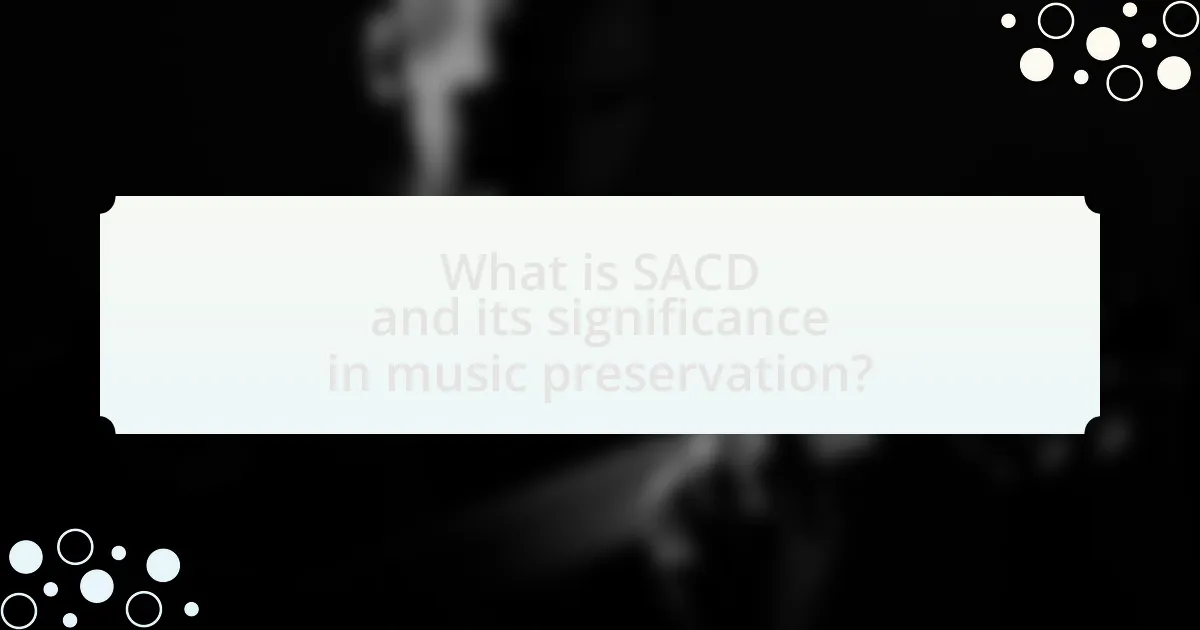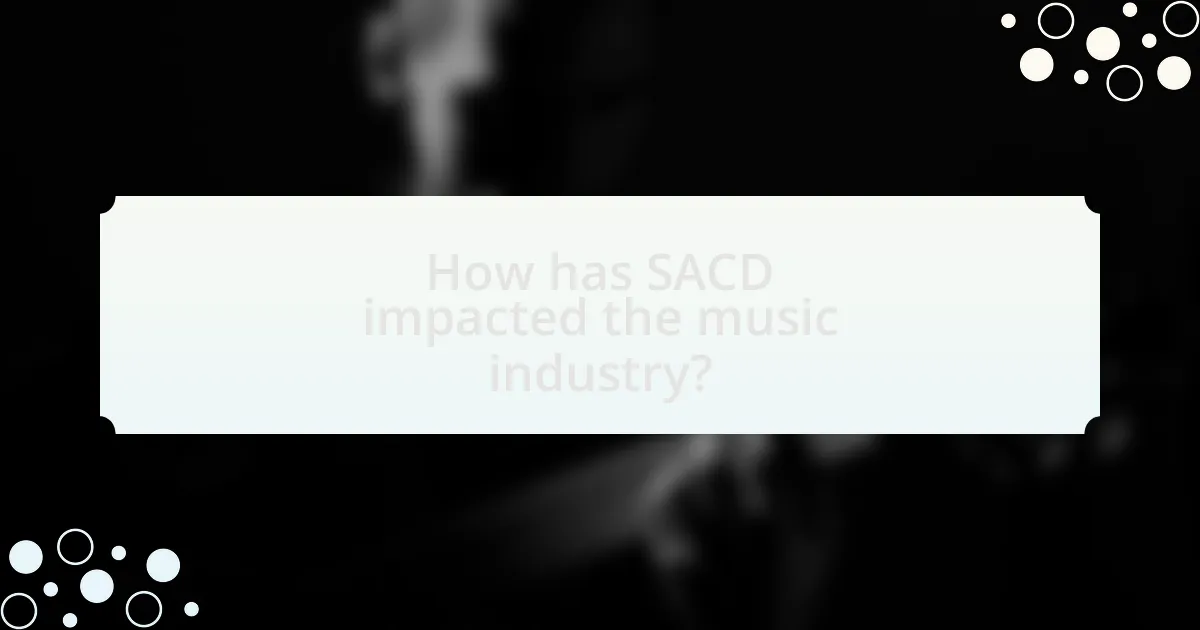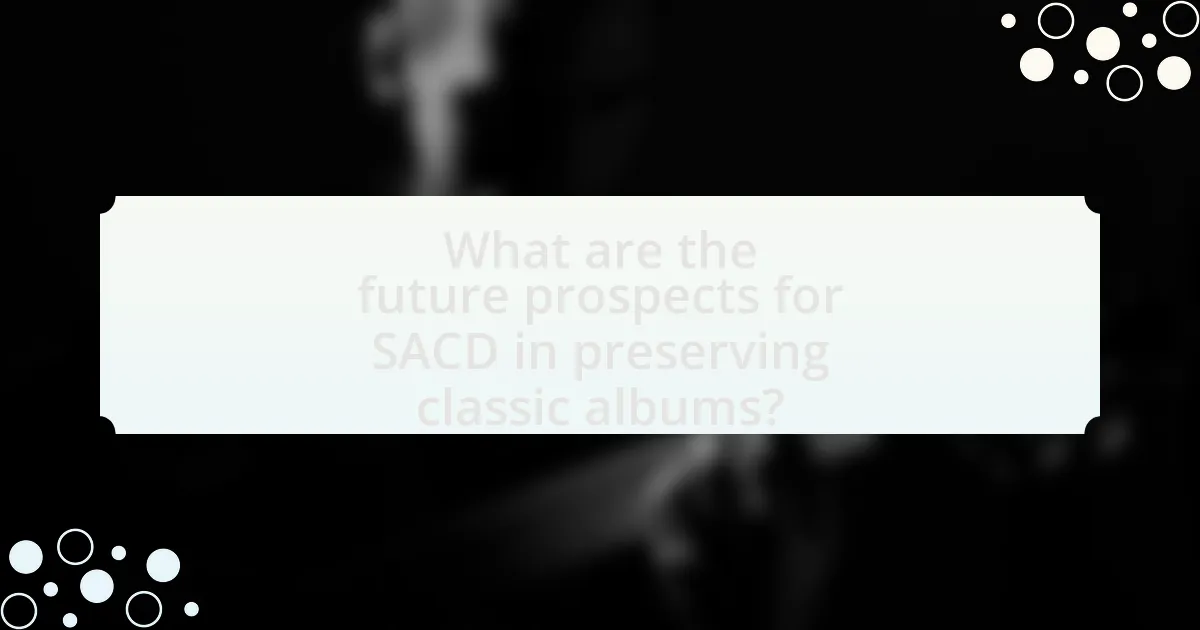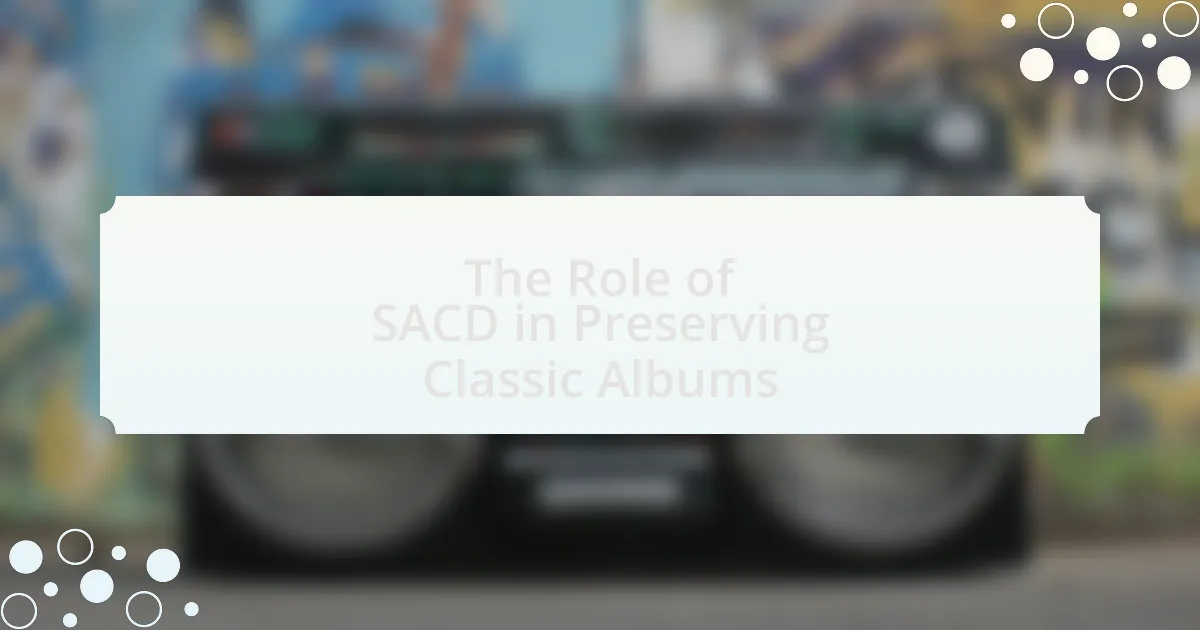SACD, or Super Audio CD, is a high-resolution audio format that plays a significant role in the preservation of classic albums by enhancing sound quality and maintaining the integrity of original recordings. Utilizing Direct Stream Digital (DSD) technology, SACD captures audio at a higher sampling rate, allowing for a more detailed and dynamic listening experience compared to standard CDs. The article explores how SACD differs from other audio formats, its unique technical features, and its impact on the music industry, including trends in the release of classic albums and the challenges it faces in the current market. Additionally, it discusses the future prospects for SACD in preserving musical heritage and offers practical tips for collectors looking to build a high-quality SACD library.
What is SACD and its significance in music preservation?

SACD, or Super Audio CD, is a high-resolution audio format that enhances sound quality compared to standard CDs. Its significance in music preservation lies in its ability to store audio in a more detailed and dynamic range, allowing for a more authentic reproduction of classic albums. SACD utilizes Direct Stream Digital (DSD) technology, which captures audio at a higher sampling rate than traditional formats, thus preserving the nuances of the original recordings. This capability is crucial for archiving and maintaining the integrity of classic music, ensuring that future generations can experience the original sound as intended by the artists.
How does SACD differ from other audio formats?
SACD, or Super Audio CD, differs from other audio formats primarily in its ability to deliver high-resolution audio through a multi-channel sound system. Unlike standard CDs that use a 16-bit/44.1 kHz resolution, SACDs utilize a 1-bit DSD (Direct Stream Digital) encoding at 2.8 MHz, allowing for a broader dynamic range and improved sound quality. This high-resolution capability enables SACDs to reproduce audio with greater detail and clarity, making them particularly effective for preserving classic albums that benefit from enhanced audio fidelity.
What technical features make SACD unique?
SACD, or Super Audio CD, is unique due to its use of Direct Stream Digital (DSD) encoding, which captures audio at a higher sampling rate than standard CDs. This method allows for a more accurate representation of sound, resulting in improved audio fidelity. Additionally, SACDs can store both high-resolution stereo and multi-channel audio formats on a single disc, enhancing the listening experience. The physical structure of SACDs also includes a hybrid layer that allows them to be played on standard CD players, while still providing the benefits of high-resolution audio on compatible devices. These technical features collectively contribute to SACD’s reputation for superior sound quality and versatility in audio playback.
Why is SACD considered superior for classic albums?
SACD is considered superior for classic albums due to its ability to deliver high-resolution audio that captures the nuances of the original recordings. This format supports multi-channel sound and higher sampling rates, allowing for a more immersive listening experience. For instance, SACD can provide audio quality up to 6.1 MHz, significantly surpassing the standard CD’s 44.1 kHz. This enhanced fidelity is particularly beneficial for classical music, where dynamic range and subtle details are crucial for an authentic representation of the performance.
What role does SACD play in preserving classic albums?
SACD, or Super Audio CD, plays a crucial role in preserving classic albums by providing high-resolution audio quality that captures the nuances of the original recordings. This format supports multi-channel sound and higher sampling rates, allowing for a more faithful reproduction of the music compared to standard CDs. The ability to store both stereo and surround sound versions on a single disc enhances the listening experience and ensures that classic albums are experienced as intended by the artists. Additionally, SACD’s longevity and resistance to degradation over time contribute to the preservation of these important musical works, making them accessible for future generations.
How does SACD enhance the listening experience of classic albums?
SACD enhances the listening experience of classic albums by providing superior audio quality through its high-resolution audio format. This format supports multi-channel sound and a wider frequency range, allowing listeners to experience music with greater detail and depth compared to standard CDs. The DSD (Direct Stream Digital) encoding used in SACDs captures audio in a way that closely resembles analog recordings, resulting in a more natural sound. Studies have shown that listeners often perceive SACD recordings as more immersive and engaging, which is particularly beneficial for classic albums that rely on intricate soundscapes and dynamic range.
What are the benefits of remastering classic albums into SACD format?
Remastering classic albums into SACD format enhances audio quality and preserves the original recordings. SACD, or Super Audio CD, utilizes a higher sampling rate and bit depth compared to standard CDs, resulting in improved sound fidelity and a more immersive listening experience. This format supports multi-channel audio, allowing for a richer soundstage that can replicate the original studio environment more accurately. Additionally, remastering can restore lost details and correct previous audio issues, ensuring that classic albums are experienced as intended by the artists. The SACD format also provides longevity, as it is less susceptible to degradation over time compared to traditional formats, thus contributing to the preservation of musical heritage.
How has SACD impacted the music industry?

SACD has significantly impacted the music industry by providing a high-resolution audio format that enhances sound quality and preserves the integrity of classic albums. This format allows for multi-channel audio, which creates a more immersive listening experience, appealing to audiophiles and collectors. The introduction of SACD has led to the reissue of numerous classic albums in superior sound quality, thereby revitalizing interest in both older music and the physical media market. For instance, labels like Sony and Universal have released SACD versions of iconic albums, which has contributed to a niche market that values high-fidelity sound.
What trends have emerged in the release of classic albums on SACD?
Trends in the release of classic albums on SACD include a resurgence in interest among audiophiles, a focus on remastering iconic recordings, and the limited edition releases of classic titles. Audiophiles have increasingly sought high-resolution audio formats, leading to a growing market for SACDs, which offer superior sound quality compared to standard CDs. Additionally, record labels have prioritized remastering classic albums from renowned artists, such as Miles Davis and The Rolling Stones, to enhance audio fidelity and attract collectors. Limited edition releases have also become common, often featuring exclusive artwork and bonus content, appealing to both music enthusiasts and collectors. These trends reflect a commitment to preserving the legacy of classic albums while catering to modern listening preferences.
Which classic albums have been successfully released on SACD?
Classic albums that have been successfully released on SACD include “Kind of Blue” by Miles Davis, “Aja” by Steely Dan, and “Dark Side of the Moon” by Pink Floyd. These albums were chosen for SACD releases due to their historical significance and popularity in the music industry. The SACD format allows for high-resolution audio, enhancing the listening experience of these iconic recordings.
How do sales figures for SACD compare to other formats?
Sales figures for SACD are significantly lower compared to more mainstream formats like CD and digital downloads. While SACD was introduced in 1999 and aimed to provide higher audio quality, its sales have remained niche, with estimates suggesting that SACD sales have only reached a few million units globally, in stark contrast to the billions of CDs sold. For instance, in 2020, CD sales were approximately 40 million units in the U.S. alone, while SACD sales were estimated at around 300,000 units. This disparity highlights the limited market penetration of SACD relative to other audio formats.
What challenges does SACD face in the current market?
SACD faces significant challenges in the current market primarily due to declining consumer interest in physical media and the rise of digital streaming services. The shift towards digital formats has led to a decrease in sales of physical audio formats, including SACDs, which are often seen as niche products. Additionally, the limited availability of SACD players and the higher price point of SACD discs compared to standard CDs further hinder market penetration. According to the Recording Industry Association of America, physical music sales have been declining steadily, with a 23% drop in 2020 alone, highlighting the broader trend affecting SACD’s viability.
How does consumer awareness affect SACD adoption?
Consumer awareness significantly influences SACD adoption by increasing demand for high-quality audio formats. When consumers are informed about the superior sound quality and enhanced features of SACDs compared to standard CDs, they are more likely to seek out and purchase SACD titles. Research indicates that consumer education campaigns highlighting the benefits of SACD, such as multi-channel audio and higher resolution, can lead to increased sales. For instance, a study by the Consumer Electronics Association found that awareness of high-definition audio formats correlates with a 30% increase in consumer interest and purchases. Thus, heightened consumer awareness directly contributes to the growth of SACD adoption in the market.
What are the limitations of SACD technology?
SACD technology has several limitations, including high production costs, limited compatibility with standard CD players, and a smaller library of available titles compared to traditional formats. The high production costs arise from the need for specialized equipment and processes to create SACD discs, which can deter manufacturers from producing a wide range of titles. Additionally, SACDs require specific players to fully utilize their capabilities, meaning that many consumers cannot access the enhanced audio quality without investing in new hardware. Furthermore, the catalog of SACD releases is significantly smaller than that of CDs, limiting consumer choice and hindering widespread adoption.
What are the future prospects for SACD in preserving classic albums?

The future prospects for SACD in preserving classic albums are promising due to its superior audio quality and longevity compared to traditional formats. SACD, or Super Audio CD, utilizes a high-resolution audio format that captures more detail and dynamic range, making it ideal for archiving classic recordings. The format’s ability to support multi-channel audio also enhances the listening experience, which can attract audiophiles and collectors. Furthermore, the ongoing interest in high-fidelity sound and the resurgence of vinyl and other physical media suggest that SACD will continue to find a niche market. Historical data indicates that SACD sales have seen fluctuations, but dedicated releases of classic albums in this format have maintained a loyal following, reinforcing its relevance in the preservation of music heritage.
How might advancements in technology influence SACD’s role?
Advancements in technology may enhance SACD’s role by improving audio quality and accessibility. For instance, developments in digital audio processing and high-resolution formats can lead to better sound reproduction, making SACDs more appealing to audiophiles. Additionally, the rise of streaming services and digital downloads could encourage the integration of SACD content into these platforms, broadening its reach and preserving classic albums in a modern format. The introduction of new manufacturing techniques may also reduce production costs, making SACDs more commercially viable.
What innovations could enhance SACD’s appeal to new audiences?
Innovations that could enhance SACD’s appeal to new audiences include the integration of high-resolution audio streaming services and the development of immersive audio formats like Dolby Atmos. High-resolution audio streaming allows listeners to access SACD-quality sound without the need for physical media, catering to the growing trend of digital consumption. Additionally, immersive audio formats provide a more engaging listening experience, attracting younger audiences who prioritize advanced technology in music consumption. These innovations align with the increasing demand for high-quality audio experiences, as evidenced by the rise in popularity of streaming platforms that offer lossless audio options.
How can SACD continue to evolve in the digital age?
SACD can continue to evolve in the digital age by integrating high-resolution audio streaming services and enhancing compatibility with modern playback devices. This evolution is supported by the increasing consumer demand for high-quality audio formats, as evidenced by the growth of streaming platforms that offer lossless audio options. Additionally, SACD can leverage advancements in digital technology, such as improved encoding techniques and metadata integration, to provide richer listening experiences and better album preservation. The ongoing interest in audiophile-grade sound systems further validates the potential for SACD to adapt and thrive in a digital landscape.
What practical tips can collectors follow when purchasing SACDs?
Collectors should prioritize purchasing SACDs from reputable sources to ensure authenticity and quality. This includes buying from established retailers, verified online platforms, or directly from manufacturers. Additionally, collectors should examine the condition of the SACD, checking for scratches or damage, as this can affect playback quality. Researching the specific SACD release is also crucial; collectors should look for reviews and comparisons to understand the sound quality and mastering differences. Furthermore, joining collector communities can provide insights and recommendations on valuable releases and potential pitfalls in the market. These practices help collectors make informed decisions and enhance their collections effectively.
How can collectors identify high-quality SACD releases?
Collectors can identify high-quality SACD releases by examining the label, mastering quality, and reviews from reputable sources. High-quality SACDs are often produced by well-known labels such as Sony, Universal, and Mobile Fidelity Sound Lab, which are recognized for their commitment to audio fidelity. Additionally, collectors should look for SACDs that have been mastered from original analog tapes or high-resolution digital sources, as this significantly impacts sound quality. Reviews from audiophile publications and forums can provide insights into the listening experience and technical aspects of the release, helping collectors make informed decisions.
What should collectors consider when building a SACD library?
Collectors should consider the audio quality, catalog availability, and compatibility of SACDs when building a library. Audio quality is paramount, as SACDs offer high-resolution sound that enhances the listening experience compared to standard CDs. Catalog availability is crucial because not all classic albums are released on SACD; collectors should prioritize titles that are known for their superior SACD versions, such as those from labels like Mobile Fidelity Sound Lab. Compatibility is also important, as not all players support SACD formats; collectors should ensure their playback equipment can handle both SACD and standard CD formats to maximize their library’s usability.

Leave a Reply